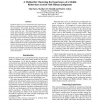197 search results - page 33 / 40 » Learning correlations using the mixture-of-subsets model |
CSB
2002
IEEE
14 years 18 days ago
2002
IEEE
Analyzing protein sequence data becomes increasingly important recently. Most previous work on this area has mainly focused on building classification models. In this paper, we i...
AAAI
2000
13 years 9 months ago
2000
If robotic agents are to act autonomously they must have the ability to construct and reason about models of their physical environment. For example, planning to achieve goals req...
ROMAN
2007
IEEE
14 years 1 months ago
2007
IEEE
–This paper presents a novel affect-sensitive human-robot interaction framework for rehabilitation of children with autism spectrum disorder (ASD) where the robot can detect the ...
BMCBI
2007
13 years 7 months ago
2007
Background: Metalloproteins are proteins capable of binding one or more metal ions, which may be required for their biological function, for regulation of their activities or for ...
ESANN
2006
13 years 9 months ago
2006
Random Forests were introduced by Breiman for feature (variable) selection and improved predictions for decision tree models. The resulting model is often superior to AdaBoost and ...

